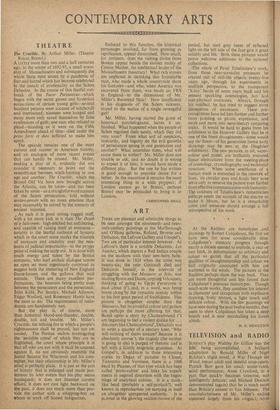ART
THERE are pleasant and admirable things to be seen amongst the nineteenth- and twen- tieth-century paintings at the Marlborough and O'Hana galleries, Roland, Browse and Delbanco, the Lefevre Gallery and Gimpel's. Two are of particular interest however. At Lefevre's there is a notable Delacroix: Les Natchez, which depicts a Red Indian couple on the seashore with their new-born babe. It was done in 1824 when the artist was twenty-six; the year Gericault died and Delacroix himself, in the intervals of struggling with the Massacre at Scio, was reading Byron and Dante, copying Velasquez, thinking of going to Egypt (everyone is mad about it'), and, in a word, was being borne along by the romantic ecstasy within to his first great period of fruitfulness. This picture is altogether simpler than the Massacre, but its youthful ardour and pathos are perhaps the more affecting for that. Based upon a story by Chateaubriand (' 1 am beginning to feel a violent dislike for ... dreamers like Chateaubriand', Delacroix was to write a quarter of a century later, 'Why will nothing of theirs endure? Because it is absolutely untrue'), the tragedy (the mother is going to die) is purged of rhetoric and is left with a faintly enigmatic grandeur. At Gimpel's, in addition to three interesting copies by Degas of pictures by Clouet, Tintoretto and Veronese, there is a 1908 head by Picasso, of that type which has been called 'proto-cubist' and links his experl, ments in negroid distortion with the begin- nings of analytical cubism. It is a Mask- like head (probably a self-portrait?), well known in reproduction yet (tarrying in itself an altogether unexpected authority. It is painted in the glowing reddish-brown of the
period, but cool grey tones of reflected light on the left side of the face give it great solidity and life. Both these pictures would prove welcome additions to the national collections.
The whole of Pavel Tchelitchew's work, from those 'near-surrealist presences he created out of still-life objects twenty-the years ago, through his experiments in multiple perspective, to the transparent X-ray' heads of some years back and his present sparkling cosmologies, has had metaphysical overtones. Always, through his intellect, he has tried to suggest extra
dimensions of awareness. These pre- occupations have led him further and further from painting as plastic expression, and more and more into semi-literary conjuring tricks. It would be hard to guess from his exhibition at the Hanover Gallery that he is one of the finest draughtsmen—some would say the finest—of his generation (some early drawings may be seen.. at the Diaghilev exhibition). The new pictuies, in oil, water- colour and pastel, are brilliantly executed linear abstractions from the meeting-place of cosmology, crystallography and molecular structure. When some semblance of a human mask is enmeshed in the network of lines, its circular eyes and koala bear nose serve only to remove the picture even further from effective communication with humanity. The coldness of Tchelitchew's romanticism perhaps needs the warmth of the theatre to make it bloom, but he is a remarkable artist and someone should arrange a full retrospective of his work.










































































 Previous page
Previous page